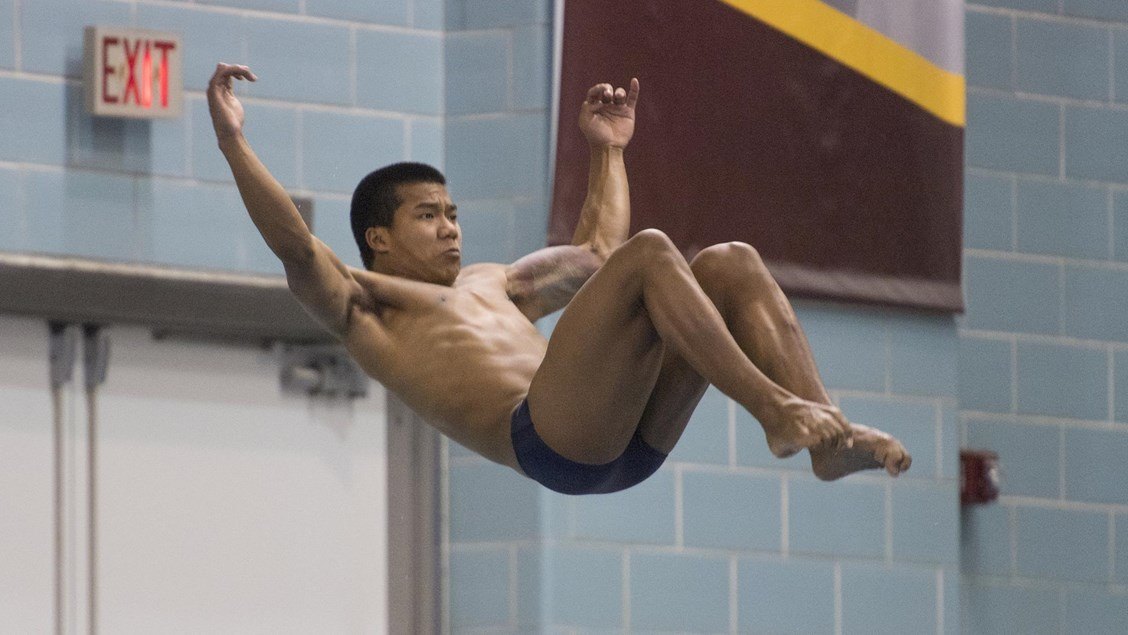Though we’re not DiveDove, we do dabble in diving coverage, and as diving can have a major impact on the NCAA Swimming & Diving Championships, we cover NCAA Zone Diving – mainly through the lens of how national diving qualifiers could impact the team points battles later this month.
2019 NCAA ZONE DIVING
- Zones A, B, D, E: Monday, March 11 – Wednesday, March 13
- Zone C: Thursday, March 14 – Saturday, March 16
- Host schools with live results links:
- Zone A: U.S. Naval Academy – Annapolis, MD
- Zone B: Auburn University – Auburn, AL
- Zone C: Purdue University – West Lafayette, IN
- Zone D: University of Texas – Austin, TX
- Zone E: Northern Arizona University – Flagstaff, AZ
- Revisit our NCAA selection primer
Jordan Windle won the 3-meter board, adding a second event to his NCAA lineup. All three Texas divers will compete on 1-meter and 3-meter later this month at NCAAs.
The big team winner on day 2 was Minnesota, which added two men’s divers to the NCAA invite list. Nick Yang was 8th on 3-meter and Alan LeBlang 9th. Both were inside the top 12 yesterday on 1-meter and so will be able to compete in both events at NCAAs. Yang was 17th at NCAAs in this event last year and should have a shot to score. Zone D is arguably the toughest diving zone: 3 of today’s qualifiers were in the 3-meter A final at NCAAs last year (Windle, Hernandez, Campbell) with two more in the B final (Thornton, Mathews).
LSU also added one more diver, bringing their total to 3 men qualified to NCAAs. Matthew Phillip took 10th to qualify, with the top 11 on men’s 3-meter earning NCAA bids.
On the women’s side, Texas added another diver to their roster, bringing the Longhorn women to four qualified divers. Sofia Rauzi was 9th, the final qualifier on 1-meter.
Minnesota’s Sarah Bacon won the event. She’s the defending NCAA champ on 1-meter. Second went to last year’s B final winner Brooke Schultz out of Arkansas, and returning A finalist Alison Gibson of Texas was third.
The only other new NCAA qualifier was Texas A&M’s Charlye Campbell, who finished 6th.
Current Qualifiers
Simplified Qualifying Procedures
Each zone earns a certain number of NCAA qualifying spots based on how that zone has performed at NCAAs in the past. Each of the three diving events will have its own number of qualifiers from each zone.
If a diver is invited in one event, they can compete at NCAAs in any other event where they finish top 12 in their zone.
Reimbursement vs invited slots don’t mean much from a spectator perspective – both can compete at NCAAs. Reimbursement slots earn NCAA reimbursement to cover the athlete’s trip to NCAAs, while invited athletes are eligible to compete, but would have to travel to the meet on the school’s dime.
Here are the qualifying allotments per zone and the reimbursement spots per zone:
QUALIFYING SPOTS PER ZONE
| WOMEN’S | 1M | 3M | PLATFORM | MEN’S | 1M | 3M | PLATFORM |
| Zone A | 6 | 5 | 5 | Zone A | 6 | 5 | 4 |
| Zone B | 9 | 8 | 6 | Zone B | 6 | 7 | 9 |
| Zone C | 9 | 8 | 12 | Zone C | 11 | 8 | 8 |
| Zone D | 9 | 12 | 9 | Zone D | 9 | 11 | 9 |
| Zone E | 8 | 8 | 9 | Zone E | 4 | 5 | 6 |
Reimbursement Spots Per Zone
| Women | Men | |
| Zone A | 5 | 5 |
| Zone B | 6 | 7 |
| Zone C | 10 | 8 |
| Zone D | 8 | 10 |
| Zone E | 11 | 5 |

Way to bring it Jordan! 🤘🏻